Season2 Project: Taste and AI Operation
August 16, 2023

Don't eat 'anything'! Taste and AI Operation
What should I eat today? Are you scrolling through delivery apps for 30 minutes just to decide? Or do you not know how to deal with the leftover ingredients in the refrigerator and end up making fried rice every day? The greatest challenge facing humanity, which has to face this dilemma three times a day... We introduce an AI that will solve the problem of 'What should I eat today?'!
Try using Taste and AI Operation
The Beginning...
The Taste and AI Operation is a project decided by 5 developers, planners, doctors, and designers from 2023 Korea and the United States who are interested in Generative AI to entrust their meals to 'artificial intelligence', rather than human choice, to tackle the timeless problem of 'What should I eat today?' that all humanity has been pondering three times a day since the beginning of humanity.
The problem of 'What should I eat today?' has never disappeared in human history, from the extreme situation of having nothing to eat to the dilemma of what to order from the menu. Especially, if someone answers 'anything' to this question, the question and answer can cycle infinitely. When someone actually says 'Let's eat this!', a 'not that, but that' situation can occur.
At times, such dilemmas lead to the creation of inventions such as 'instant noodles'. The initial 5 members (Dolphin, Woodie, Gyeolmyungjacha, Sang, Moana) decided to entrust the responsibility for this problem not only to humans but also to artificial intelligence, especially to the algorithm developed by Sam Altman.
Source: Taste and AI Operation Namuwiki
The Project
Participating in the Taste and AI Operation is very simple.
First, visit the operation page.
Choose the desired method on the landing page, '1)
Let's eat anything!' or '2)Enter the ingredients you want to add'.2-1) In the case of 'Let's eat anything!', it is a choice to entrust all authority over my meal to the artificial intelligence used in the operation.
2-2) In the case of 'Enter the ingredients you want to add', it is to consider the current status of your refrigerator and other surrounding situations and hand over the authority to the artificial intelligence. You can discuss with the artificial intelligence to have a variety of things that you want
After going through this selection process, the final recipe comes out, and depending on whether you like the recipe or not, you can review it, and if you really like it, you can save it or share it with your acquaintances through a link!
3-1. However, saving and reviewing are possible only after logging in to Google.
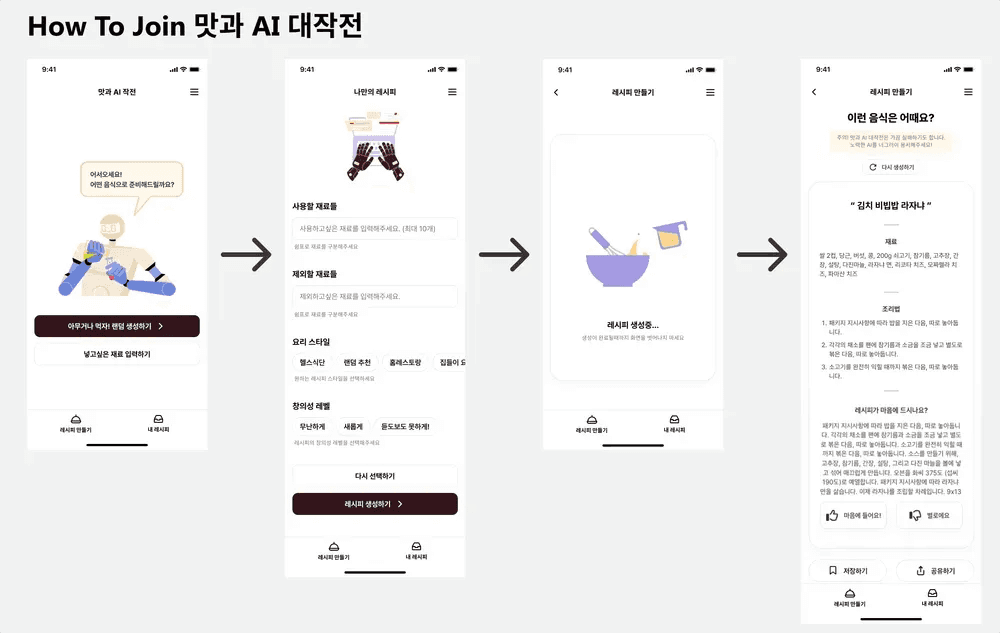
How to use the Taste and AI Operation
The Answer...
In this operation, many results are created through various experiments and tests. Below is a part of the first successful recipe of the Taste and AI Operation after several attempts. The researchers actually tried cooking at home and were able to solve a meal that was comparable to a Michelin-star restaurant in Korea.
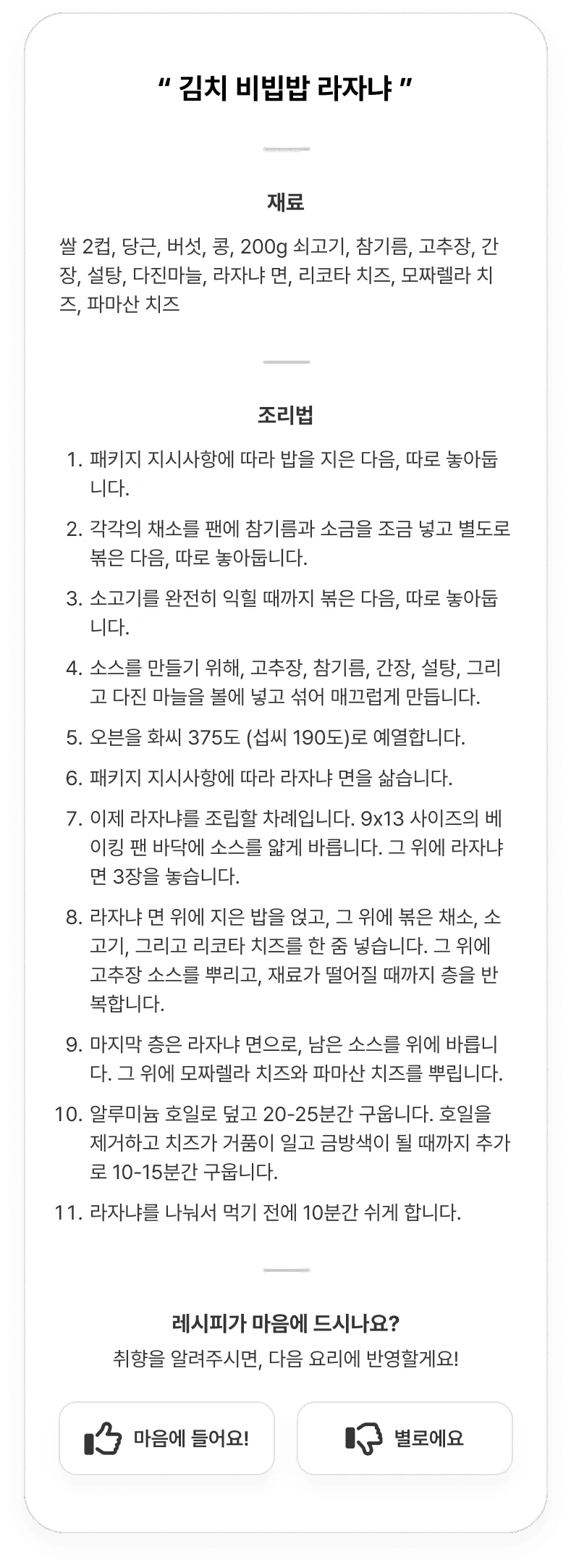
Example of recipe generation result
Development Process
1. Idea Research and Selection
We focused on creating a service that is fun and enjoyable for our team and has clear inputs and outputs.
We wanted to try using Text Generation AI and decided to create an AI recipe service that reflects the preferences of team members who like cooking.
If you are curious about our idea research process, please refer to the document below!
2. Writing PRD and Making Wireframes
We defined the entire functions and purpose of the service through writing the PRD document based on feasibility research and competitor analysis.
This document was updated periodically so that all team members could refer to it and develop it throughout the development process.
Sang organized the PRD document and you can check it out on the page below!
Take a peek at the PRD document
We also received help from AI while making the wireframes for the entire app.
We used a Figma plugin called WireGen to create the wireframes.
A very reasonable format of results came out, and it was very helpful in constructing the wireframe.
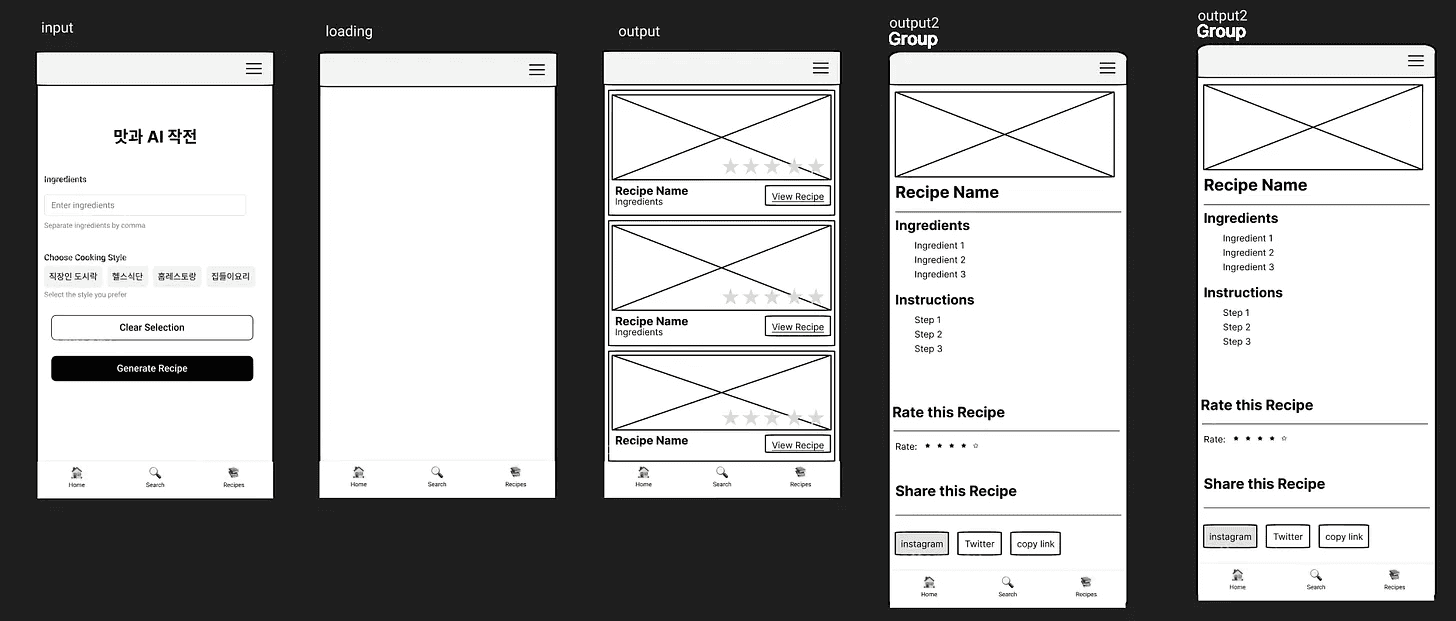
Result of making wireframes using the WireGen plugin
3. Front-end Development with Bubble
The front-end development of the Taste and AI Operation app was implemented using the no-code service Bubble.
It is not well known in Korea yet, but since it has been around for more than 7-8 years, it was a very good service for a light early stage team to use because it has a wide variety of plugins.
Woodie took charge of the overall front-end development of the app, and by implementing a high-level prototype during the wireframe stage, we were able to visualize the imagination of all team members.

Service prototype implemented at a high level using the no-code web development tool Bubble
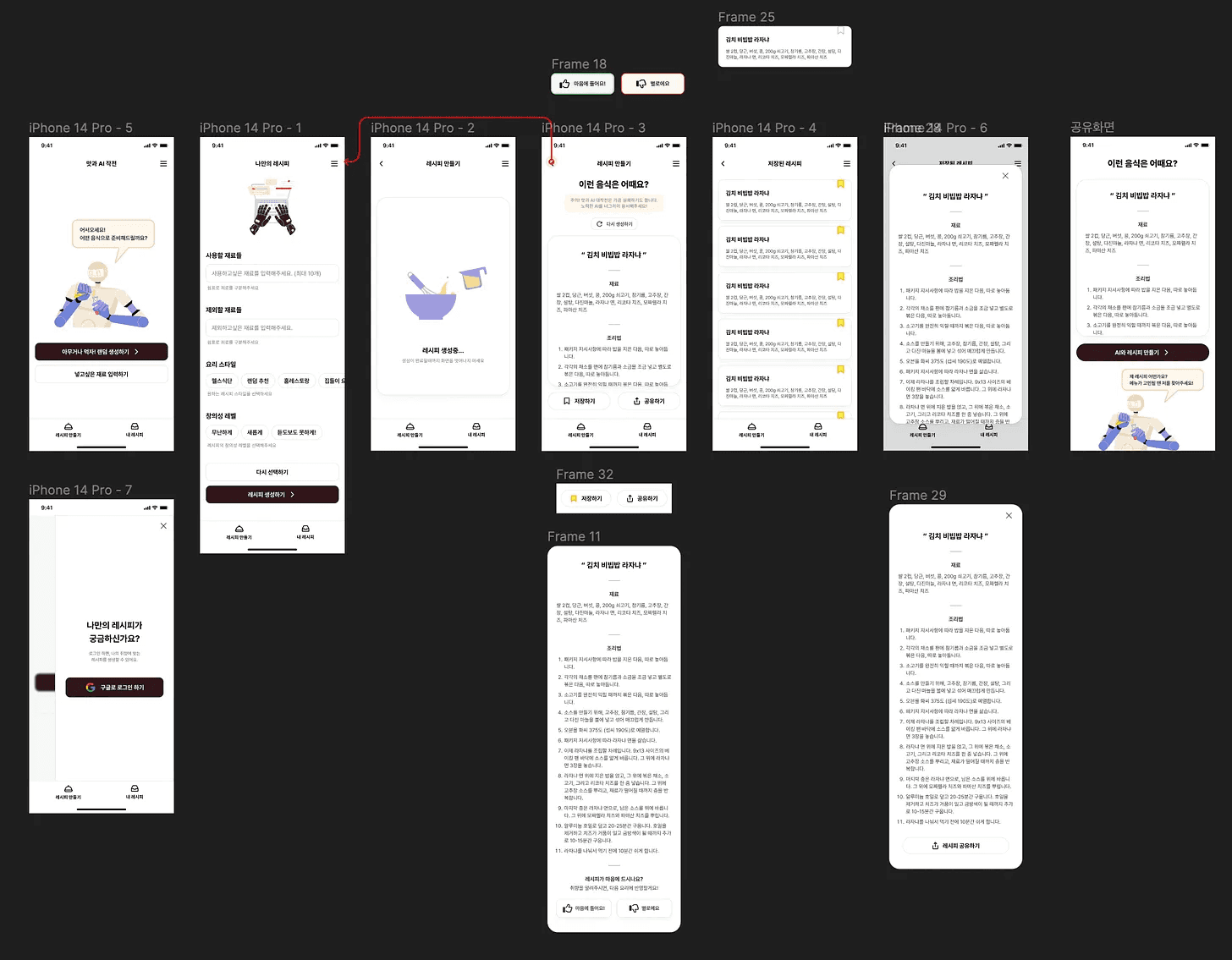
Final UX/UI design
4. Prompt research, API development, and integration
Various research continued in various directions to solve the persistent problem of 'obtaining results that deviate from a fixed format' in text generation.
We tried adding a process to parse the answers, and we also tried to calm down the Chat GPT here and there. Here is a part of Dolphin's fierce contemplation process. 🙂
After prompt research, we finalized the backend API and integrated it with Bubble to complete the app development.
5. Quality Analysis (QA)
After development was completed, we went through the QA process to check if the service was working as planned.
The PM and team members used the service directly, and collected bugs and various suggestions in one document.
Since there is a deadline, we cannot accept all suggestions, so we handle the QA list in priority order starting from the highest priority.
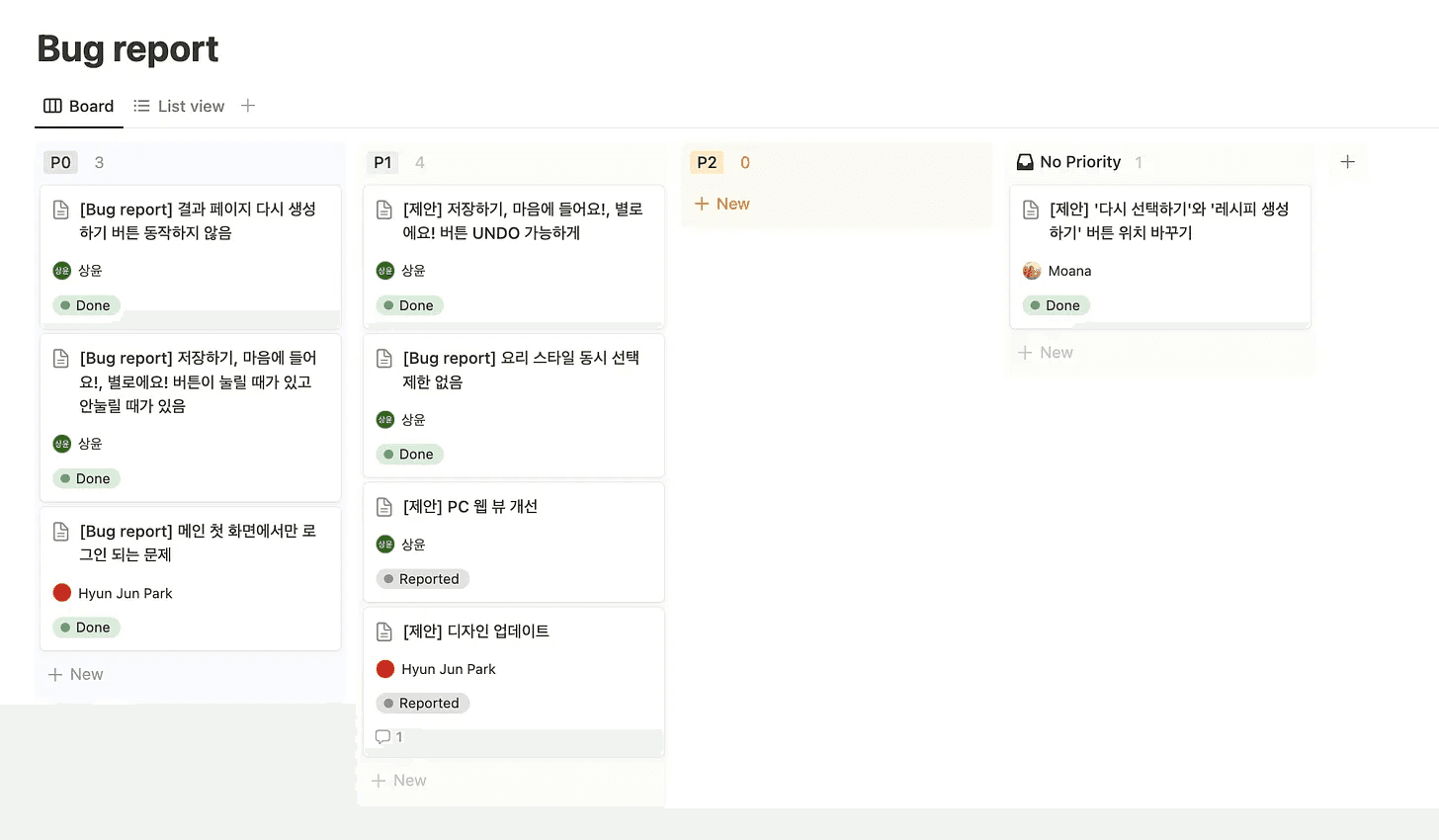
QA sheet of the Taste and AI Operation team
Lessons Learned from the Project
I learned that it is very difficult to control quality with just the GPT API. I realized that without fine-tuning, it is difficult to control in detail.
It was difficult to define how much time we should spend and to what scope we should make the service in a side project. I feel like I learned while confronting this directly.
It was nice to see what each person is good at while dividing roles and working on the project with people of various backgrounds.
Reviews from Team Members
Sang
I'm satisfied with making a product that works within a short period of time. Also, it was good to try using Chat GPT for a purpose other than just searching, but it was difficult to prompt Chat GPT, and I found out that it is clearly better in English than in Korean...
Dolphin
I'm satisfied that we completed the product within the given period. But if the AI does not give good results, I feel more stuck than I thought...
Woodie
I'm glad that we made a service to the extent that it can be opened to regular users. Although it wasn't completed, it was satisfying that we were able to maintain it if we kept up with it. Overall, I was able to learn what is necessary when applying AI technology to a service that regular users can use.
Gyeolmyungjacha
It was nice to gain experience in a new field with various people. I had no knowledge of AI, but I learned a lot about AI-related research and services by researching AI and using AI services during the project period. It was a completely new field, but I learned a lot by finding and using AI-related services.
By BetaAI
© 2023
